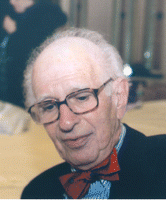Nobel Prize in Physiology or Medicine winners are a big draw anywhere, so it is no surprise that about 100 psychoanalysts packed a room in the Waldorf Astoria Hotel in New York on January 13 to hear from one.
It was Eric Kandel, M.D., winner of a 2000 Nobel Prize in Physiology or Medicine for his research on learning and memory, a university professor at Columbia University, and the only American psychiatrist ever to be awarded the Nobel Prize. Moreover, he has a longstanding interest in psychoanalysis. He gave his talk at the winter meeting of the American Psychoanalytic Association.
He sat at the middle of a long table in a very long room, with analysts surrounding him on all sides. A photo of the father of psychoanalysis, Sigmund Freud, had been projected onto a movie screen at the end of the room. Freud looked as if he were keeping a critical ear open to what his one-time compatriot in Vienna might say. (Both Freud and Kandel left Vienna in 1938 once Hitler took over Austria.)
The thrust of Kandel's talk was that if psychoanalysis is going to survive, it must incorporate neuroscience. He made his case articulately, thoughtfully, and with a sense of humor.
Analysis—Most Elaborate View of the Mind
"Analysis is the most elaborate and nuanced view of the mind that we have," Kandel said. "Bob Michels talked about this recently. [Michels, a university professor of psychiatry at Weill Cornell Medical College, was also present at the talk.] But analysis is not empirical, and we need independent evidence for two points—whether it works (under what circumstances and for whom), and if so, how it works, that is, what alteration does it produce in the brain? Neurobiology should join forces with analysis to do this. I think it would be an enormous advance."
He laid out a succinct plan for how it might be done, using the father of cognitive therapy, Aaron Beck, M.D., as a prototype. Beck, he explained, had observed that depressed patients often viewed themselves as losers, even though they were not, devised a treatment to correct this erroneous cognitive outlook, wrote a manual so that other therapists could also apply the treatment, and then conducted outcome studies to see whether his treatment worked. "Beck is a bold guy who did things," he asserted. Analysts, he ventured, could do something similar—write a manual for analysis so that it is reproducible in the hands of different analysts and then compare its outcomes with those of other psychotherapies. By the way, he noted, the British health care system pays for cognitive-behavioral therapy (CBT), but not for analysis, because the former has robust evidence to back it.
"Certainly funding is a problem, but that is a problem in all areas of science," Kandel added. Analysts might approach foundations to finance such research, or they might ask patients who've been helped by analysis to finance these studies, he proposed.
Analysts Have Their Say
In a discussion following his talk, one analyst asked, "Could you measure an endpoint for research into the analysis of people who undergo it because of a career or relationship problem?"
To which Kandel replied, "As a result of analysis you love a little better, you work a little better. Why couldn't you measure such endpoints?"
The questionner then asked if it's possible to measure such changes in the brain.
"Sure, why not? Analysts need to join in to develop appropriate methods for doing this," Kandel replied.
Another analyst at the talk suggested that "perhaps we should focus on studying sadism, masochism, sexual problems—problems that other types of therapies do not help, but that analysis does."
Kandel responded that the analyst's question was "insightful."
"There was a study that compared psychodynamic psychotherapy with CBT for depression, and the psychodynamic patients had a better outcome," another analyst noted.
"I think that is wonderful, and we just need more of the same," said Kandel.
"There was a flood of research on analysis published recently," another analyst commented. "Maybe we aren't doing a good job of advertising such findings."
"You may be absolutely right," Kandel said. "I was not aware of many such studies. One needs to show under what circumstances analysis or analytic psychotherapy works and what type of therapy is particularly effective and for whom. So we need not a few selected studies, but a systematic examination of specific forms in specific diagnostic categories."
"I disagree with you on one thing," a San Francisco analyst said. "If you take an MRI of my brain, that is my brain, not my mind. How can we bridge this gap?"
"If you believe as I do that all mental processes derive from the brain, then the problem falls apart," was Kandel's reply.
However, one of Kandel's observations—that psychoanalytic institutes are "trade unions"—aroused the ire of the audience. Said one: "I once was a professional trade-union organizer, and analytic institutes are not like trade unions, but more like guilds!"
"I apologize," Kandel said. "Yet I don't think the analytic institutes are fulfilling their functions. They need to engage in research, and it would be ideal if they were affiliated with universities. In truth, if analysis died, it would not affect me, but you people have a serious investment in it," he said. "I can see why you feel threatened, but you have to do something about it. . . . I want you to show the person on the street with no interest in analysis that it works."
Still another of his comments propelled his talk to a congenial conclusion: "I grant that the challenge of bringing neuroscience to bear on analysis is complicated, but life is complicated! I think you can determine what parts of the brain are involved in unconscious processes or superego functions. I think analysts can bring questions to bear with brain imaging that no one else is asking."

